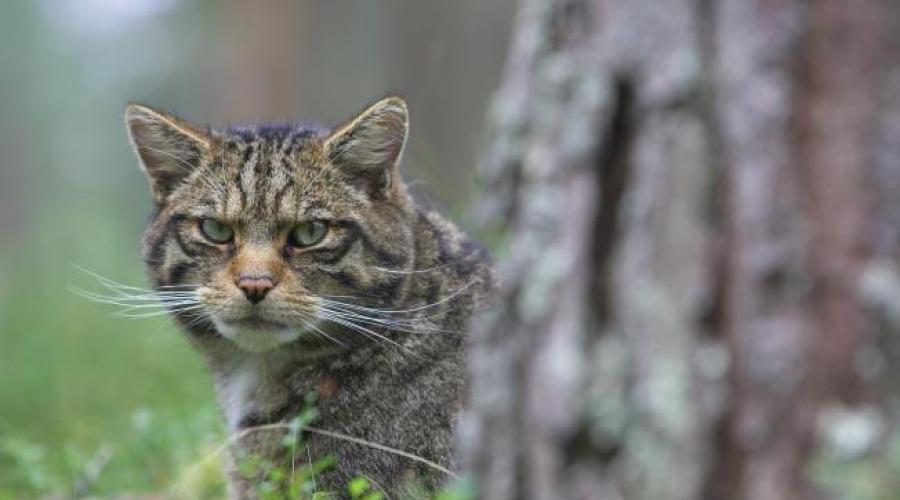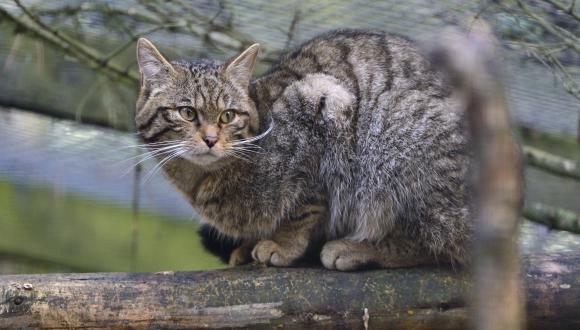
Wildcats
Very few people have seen a wildcat – it’s Scotland’s most threatened mammal, with perhaps only a few hundred still alive.
The Scottish wildcat (Felis silvestris) is one of our most elusive carnivores and the only native member of the cat family still found in the wild in Britain. The wildcat is a European protected species.
The wildcat would have once been found throughout mainland Britain. Persecuted for centuries, its range steadily declined until by the First World War it was only found in the north west of Scotland. After this the range began to recover and the current range consists of areas in mainland Scotland north of the Highland Boundary Fault. Estimates of wildcat numbers in Scotland vary greatly and our knowledge about current populations is patchy. This is because wildcats are elusive and because it’s not always easy to distinguish between wildcats and hybrid cats (see below). But trail-camera surveys conducted from 2010 to 2013 across the wildcat’s range in Scotland estimated that there are only 115 to 314 individuals.
Scottish wildcats prefer to live on the woodland edge, in the margins of mountains and moorlands, with rough grazing. They generally avoid high mountain areas, exposed coasts and intensively farmed lowlands.
Like most cat species, wildcats are solitary except when breeding. They can be active by day and night, and their diet varies across the country. Rabbits are the favoured prey of wildcats, but when or where rabbit numbers are low, voles and mice are probably the next most important food source for wildcats in Scotland.
Hybridisation
The population of wild-living cats in Scotland contains a mixture of domestic and wildcat genes, and the animals have varying physical characteristics.
It’s not possible to say with certainty that a cat with classic wildcat markings is genetically ‘pure’. But wild-living cats that look like wildcats should be treated as wildcats and regarded as legally protected.
Learn how to identify a Scottish wildcat on the Saving Wildcats website.
Threats to Scottish wildcats
The main threat to Scottish wildcats is genetic extinction due to hybridisation with feral cats, domestic cats and existing hybrids.
They are also at risk from:
- incidental harm from predator control activities
- feline disease
- road collisions
- fragmentation or disturbance to habitats through development or changes in land management
Conservation of Scottish wildcats
Scottish wildcats were first identified as a priority for conservation action in 2007, in our Species Action Framework. This helped to kick off the Cairngorms Wildcat Project 2009–2012, to learn more about the cats living wild in the Cairngorms National Park.
Read the Cairngorms Wildcat Project Final Report.
NatureScot works with a wide range of partners to expand the programme of action for wildcats. Together we launched the Scottish Wildcat Conservation Action Plan in 2013.
Scottish Wildcat Action (SWA) was the first national conservation project set up to meet the action plan's aims. Led by NatureScot, the project was supported by the Heritage Lottery Fund and informed by a scoping report into priority areas for wildcat conservation. SWA launched in 2015 and finished in 2020.
Read more about the outcomes of the SWA project in our Scottish Wildcat Action Summary Report and our Scottish Wildcat Action Specialist Reports.
Building on the pioneering work of SWA, Saving Wildcats was established to further the conservation and recovery of the species.
Saving Wildcats Project
Saving Wildcats (#SWAforLife) is a European partnership project dedicated to Scottish wildcat conservation and recovery.
We aim to prevent the extinction of wildcats in Scotland by breeding and releasing them into the wild.
Building on the work of Scottish Wildcat Action, the first national conservation plan for wildcats, Saving Wildcats will:
- Establish Britain's first large-scale dedicated conservation 'breeding for release' centre for wildcats.
- Grow the population of wildcats through release of wildcats into the wild.
- Continue to remove the threats facing wildcats in the Highlands to create other safe areas for wildcat reintroductions.
- Work with local communities to understand how best people can benefit from the presence of wildcats.
This project brings together the expertise and skills of national and international organisations.
The conservation breeding and release of wildcats is being carried out by the Saving Wildcats partnership led by the Royal Zoological Society of Scotland (RZSS) in collaboration with NatureScot, Forestry and Land Scotland (FLS), The Cairngorms National Park Authority (CNPA), Norden's Ark and Junta de Andalucía.
Protection of Scottish wildcats
Read about the wildcat as a protected species.
Learn about wildcats and licensing.
Read our guidance for planners and developers on wildcats.
Read the FCS Guidance note 35d (200) - Forest operations and wildcats in Scotland
Report a sighting
Find out how to submit records of mammal sightings on The Mammal Society website.
Find out more
Read our latest news release 'First-ever Scottish wildcat release approved' 24 March 2023
NatureScot Licence Application 220947 - Decision Document
Scottish Wildcat Survey 2006–2008: NatureScot Commissioned Report No. 360
Wildcat chapter – Species Action Framework Handbook
Contact
If you already have a licence number, include it in the subject line of your email, or have it to hand when you call.




